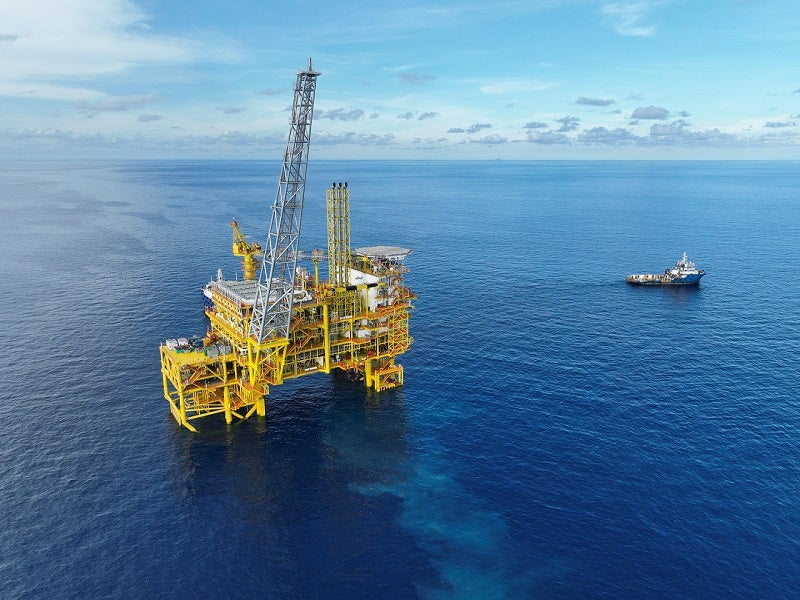The Jerun offshore gas production project is located offshore Sarawak in Malaysia.
The field’s partners comprise SapuraOMV Upstream (40%, operator), Sarawak Shell (30%) and Petronas Carigali (30%).
The financial investment decision (FID) for the field’s development was reached in 2021. The Jerun gas field commenced gas production in July 2024.
In April 2024, France-based energy company TotalEnergies signed an agreement with Sapura Upstream Assets (SUA) to acquire a 50% interest in SapuraOMV Upstream for $530m, following an initial agreement signed with OMV in January 2024 for its 50% interest in SapuraOMV Upstream.
TotalEnergies will own a 100% interest in SapuraOMV Upstream once both transactions are finalised in the latter half of 2024.
Jerun gas field location
The Jerun gas field lies approximately 160km north-west of Bintulu and 190km north-west of Miri in Sarawak, Malaysia at a water depth of approximately 87m (285ft).
Situated in Block SK 408, the field spans 4,480km² with water depths ranging from 70m to 115m.
Discovery and appraisal at Jerun gas field
Five wells were drilled back-to-back in Block SK 408 in 2014 leading to the discovery of approximately 2.2 trillion cubic feet (tcf) of gas.
A three-well drilling campaign was carried out in 2015 targeting non-associated gas within the primary target Late Miocene Carbonate reservoirs.
The Jerun-1 well, located 5km north of the 2014 Bakong gas discovery, identified an 800m gross gas column, marking it as a multi-trillion cubic feet gas discovery.
The Jeremin-1 well, located 15km west of the F9 gas field, encountered a 104m gross gas column.
However, the Putat-1 well, located 20km north of the Cili Padi gas field, field came out dry. All wells were safely plugged and abandoned.
Jerun gas field development details
The Jerun field’s infrastructure includes an integrated wellbay and the Jerun A central processing platform (CPP) capable of producing up to 550 million cubic feet per day (mmscfd) of gas. The platform can also produce 15,000 barrels per day (bpd) of condensate at peak.
The Jerun A CPP features a 15,000t topside and 10,000t jacket, alongside piles weighing 5,000t.
An 80km long, 30in carbon steel pipeline transports gas from the Jerun platform to the E11 R-B production hub. Gas and condensate from the Jerun A CPP are dehydrated and metered. The condensate is combined with the Jerun gas stream and exported to customers in Bintulu, including Malaysia LNG.
An export compression is planned to be installed in the future to prolong the production life as reservoir pressure declines. As sweet blend gas runs out in the future, an acid gas removal (AGR) system is anticipated to treat Jerun gas to the required sales specifications.
The export compression and AGR facility are planned to be installed on a future separate platform that will be bridge-linked to the Jerun A CPP.
E11 R-B production hub details
The E11 R-B production hub has been producing since 1982 under the MLNG production sharing contract. It was previously operated by Sarawak Shell (SSB).
In January 2021, Petronas, through its subsidiary, Petronas Carigali (PCSB), assumed operatorship. The E11 R-B platform is currently operated by SK Gas.
Contractors involved
Malaysia Marine and Heavy Engineering (MMHE), a subsidiary of Malaysia Marine and Heavy Engineering Holdings (MHB), secured the engineering, procurement, construction, transportation and installation, and hook-up and commissioning services (EPCIC) contract for the Jerun field infrastructure in April 2021.
Sarens, a heavy lift and engineered transport solutions provider, was contracted by MMHE to skid, and load out heavy modules of the Jerun A CPP.
OceanMight, an oil and gas fabricator, was subcontracted by MMHE in March 2022 to provide various services for the fabrication of the platform jacket’s piles.
Global Maritime, a Norway-based offshore and engineering consultancy, was contracted to deliver marine warranty services (MWS) for the Jerun A CPP jacket and topside.


